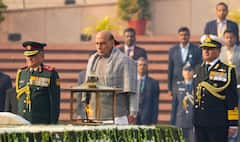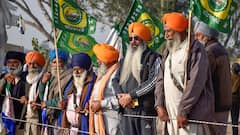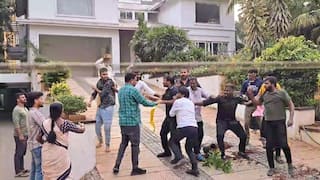'Karmic Cycle Comes To A Close': How Ajit Pawar Rebellion Bears Shades Of Sharad Pawar's 1978 Revolt
Two Pawars and two revolts: Ajit Pawar's rebellion is a stark reminder of Sharad Pawar's coup in 1978 against Vasantdada Patil. Here is a look at the differences and similarities of the two revolts.

The suspense in the Ajit Pawar-vs-Sharad Pawar saga doesn't seem to be nearing an end anytime soon. To top it all, going by what Maharashtra Navnirman Sena chief Raj Thackeray and NCP's rebel leader Ajit Pawar said, it didn't start anytime in the near past either. Although Ajit Pawar's disgruntlement against his uncle and NCP chief started back in 2009, the politics of sharp U-turns to split a party started in Maharashtra back in 1978, with none other than Sharad Pawar at the centre of it.
Springing a surprise on his party, the NCP, Ajit Pawar on July 2 reached the Raj Bhawan in Mumbai to take oath as the deputy chief minister of Maharashtra. Along with him, eight MLAs of the NCP also took oath at an event attended by CM Eknath Shinde and Deputy CM Devendra Fadnavis. Ajit Pawar, after initially saying that Sharad Pawar still was the NCP president, staked claim to the party symbol and name on Wednesday. He was also "unanimously" declared the national president of the "real NCP" by the members of his faction.
Raj Thackeray later said such a big development in Maharashtra's politics couldn't have happened without Sharad Pawar's involvement. He pointed out that Sharad Pawar himself initiated such political manoeuvres in the state, dating back to 1978 when he experimented with the formation of the Purogami Lokshahi Dal (PuLoD) government.
Chhagan Bhujbal, too, said Sharad Pawar had also left the Vasantdada Patil government to form his own alliance with the Janata Dal and become the CM.
So what actually happened in 1978?
Political analyst Jai Mrug says that what happened on July 2 was a "karmic cycle coming to a close". The Congress in Maharashtra saw a major upheaval in 1978 due to a strong rebellion by the influential Sharad Pawar, who was already an expert in politics. Having learnt the tricks of the trade under Yashwantrao Chavan, known as "Pratishivaji" or "New Shivaji", Sharad Pawar had risen up the ranks within the Congress very fast.
In 1978, he challenged the authority of the then-Maharashtra CM Vasantdada Patil, who was known as the first mass leader in the state's politics. The events surrounding this rebellion had far-reaching consequences and marked a significant turning point in Maharashtra's political landscape.
A Congress Loss, A Split, And A Marriage Of Convenience
To understand the context of the rebellion, it is important to delve into the political dynamics of Maharashtra during that time. This was a time of utter turmoil for the Grand Old Party of India, which had tasted defeat for the first time, and that too a humiliating one. It won only 154 seats, losing 198 from the previous elections. The imposition of Emergency cost Indira Gandhi her Bareilly seat and her son Sanjay the Amethi constituency. The election was won by the Janata Party — an alliance of the Indian National Congress (Organisation), the Bharatiya Lok Dal, the Bharatiya Jana Sangh, and the Praja Socialist Party.
After the 1977 general elections, the Congress split into two parties — the Congress (I), led by Indira Gandhi, and the Congress (Urs), led by D Devaraj Urs, the first chief minister of Karnataka. Pawar joined his mentor Yashwantrao Chavan in following Urs.
However, after the 1978 Maharashtra Assembly polls, the two sides came together to prevent the Janata Party from coming to power in the state as well. The Janata Party had emerged as the single-largest party with 99 seats. Thus, Congress (I), with 62 seats, and Congress (Urs), with 69 seats, came together to assume power under Vasantdada Patil. But Indira Gandhi's Maharashtra joy was shortlived.
Sharad Pawar broke away from the Maharashtra Congress government of Vasantdada Patil and formed a coalition government with the Opposition — Janata Party and the Peasants' and Workers' Party of India. This was his first stint as the chief minister of Maharashtra. In the process, he became Maharashtra's youngest CM at the age of 38, a record that he holds till date. His government lasted till 1980.
Why Sharad Pawar Moved Away From Vasantdada Patil
Vasantdada Patil, widely regarded as the first "mass leader" in Maharashtra's politics, was a powerful figure within the Congress and had established himself as a prominent leader in the state. He had a strong grip on the party's machinery and wielded considerable influence over its decision-making process.
However, within the party, there was growing discontent over Patil's style of functioning. Many party members, including Sharad Pawar, felt that Patil was centralising power and making unilateral decisions without consulting other leaders. Pawar, who had been an important member of the Congress party and had served in various ministerial positions, began to feel marginalised and ignored by Patil's leadership. According to some media reports, Pawar and his mentor Yashwantrao Chavan were even humiliated by the Congress (I) leadership, especially by Nashikrao Tirpude, who was the Deputy CM back then.
Another reason was that Sharad Pawar felt that Indira Gandhi was too controlling and imposing, and Vasantdada Patil, the mass leader that he was, had little say over her in government or party matters.
Moreover, a cold war was already brewing between Indira Gandhi and Yashwantrao Chavan-Sharad Pawar duo. Indira Gandhi had not forgotten that Pawar had followed his mentor Yashwantrao in backing Neelam Sanjeeva Reddy as the Presidential candidate against her choice of VV Giri (Reddy eventually lost and a multi-fold split in the Congress). This contributed to increasing the divide between the Indira Gandhi faction and an anti-Indira group within the Congress (I) in Maharashtra.
The Historic Resignation — What Happened In 1978
Just like Ajit Pawar sprung a surprise on July 2, Sharad Pawar, who was the lndustry and labour minister then, shocked the state on July 18, 1978, when he submitted a letter to then governor Sadiq Ali, informing him of his decision to break away from the Congress (I) with 38 MLAs and form a new party. He also staked claim to the post of legislative party leader.
"The two instances are very similar," political analyst Jai Mrug says. "Even Sharad Pawar effected an overnight coup. Just the previous evening, he had pledged support to Vasantrao Patil and on July 18 he reached the governor's office. Tirpude is said to have warned Patil, but it was too late. Patil couldn't even believe his deputy. He said: 'Pawar just met me.' He was to resign the same evening as Pawar took oath as the CM during the assembly session on July 18."
He adds: "The difference between Pawar senior and Ajit's rebellions perhaps lies in the fact that Vasantrao Patil might not have been aware of Pawar's coup as those days such political U-turns were rare. Sharad Pawar's coup was a one-of-a-kind."
The rebellion against Patil had a profound impact on Maharashtra's political landscape. Sharad Pawar emerged as a powerful leader and a force to be reckoned with. He became the chief minister of Maharashtra for the first time in 1978 and went on to serve multiple terms in that position. Pawar's rebellion also led to a realignment of political forces in the state, with the Congress losing its hegemony and giving rise to a multi-party system.
Way Ahead For The Pawars
Echoing Raj Thackeray, Mrug says Sharad Pawar, in all likelihood, was aware of Ajit's impending rebellion. "A look at his interviews a month ago will show us that he was aware of it the whole time, but had probably accepted it as destiny. With Ajit's rebellion, the Pawar karmic cycle has come to a close," he says.
But all love is not lost between the two Pawars. While Ajit Pawar has so far refrained from vicious badmouthing, his supporters have called Pawar their "God". "Ajit Pawar will not take out any hatred or be vicious in this rebellion. If one might have noticed that despite the sudden move [and Ajit Pawar nearly snatching Sharad Pawar's party from him], the two are not spewing venom against each other [as was the case in the Shiv Sena]," Mrug says.
But it may be more because of future convenience than out of respect. "Pawar, who was most likely aware of the rebellion coming, seems to have sort of accepted it as fate. Ajit, on the other hand, knows that local leaders are with the senior Pawar. These local leaders have their hold over the assembly and parliamentary constituencies and Ajit can't afford to even one wrong move," says Mrug. "Both the Pawars will keep their options open. They might even contest elections together in 2024. I won't write that off," he adds.
Trending News
Top Headlines






































